Prior and Posterior Linear Pooling for Combining Expert Opinions: Uses and Impact on Bayesian Networks—The Case of the Wayfinding Model
Abstract
:1. Introduction
2. Bayesian Networks
3. Linear Pooling Methods for Combining Opinions
Advantages and Disadvantages of Linear Pooling Methods for Combining Opinions
4. The Wayfinding Bayesian Network Model
5. Case Study: Linear Pooling Methods and the Wayfinding Bayesian Network Model
5.1. Prior Linear Pooling (PrLP)
5.2. Posterior Linear Pooling (PoLP)
6. Conclusions
Acknowledgments
Author Contributions
Conflicts of Interest
References
- Johnson, S. Integrated Bayesian Network Frameworks for Modelling Complex Ecological Issues. Ph.D. Thesis, School of Mathematical Sciences, Faculty of Science and Technology, Queensland University of Technology, Brisbane, Australia, 2009. [Google Scholar]
- Pollino, C.; Woodberry, O.; Nicholson, A.; Korb, K.; Hart, B. Parameterisation and evaluation of a Bayesian network for use in an ecological risk assessment. Environ. Model. Softw. 2007, 22, 1140–1152. [Google Scholar] [CrossRef]
- Friedman, N.; Linial, M.; Nachman, I.; Pe’er, D. Using Bayesian Networks to Analyze Expression Data. J. Comput. Biol. 2000, 7, 601–620. [Google Scholar] [CrossRef] [PubMed]
- Heckerman, D. Probabilistic Similarity Networks; Technical Report STN-CS-1316; Stanford University Departments of Computer Science and Medicine: Stanford, CA, USA, 1990. [Google Scholar]
- Taroni, F.; Biedermann, A.; Garbolino, P.; Aitken, C. A general approach to Bayesian networks for the interpretation of evidence. Forensic Sci. Int. 2004, 139, 5–16. [Google Scholar] [CrossRef] [PubMed]
- O’Hagan, A.; Buck, C.E.; Daneshkhah, A.; Eiser, R.; Garthwaite, P.; Jenkinson, D.; Oakley, J.; Rakow, T. Uncertain Judgements: Eliciting Experts’ Probabilities; John Wiley & Sons: Hoboken, NJ, USA, 2006. [Google Scholar]
- Genest, C.; Zidek, J.V. Combining probability distributions: A critique and annoted bibliography. Stat. Sci. 1986, 1, 114–135. [Google Scholar] [CrossRef]
- Albert, I.; Donnet, S.; Guihenneuc-Jouyaux, C.; Low-Choy, S.; Mengersen, K.; Rousseau, J. Combining Expert Opinions in Prior Elicitation. Bayesian Anal. 2012, 7, 503–532. [Google Scholar] [CrossRef]
- Genest, C.; Weerahandi, S.; Zidek, J.V. Aggregating opinions through logarithmic pooling. Theory Decis. 1984, 17, 61–70. [Google Scholar] [CrossRef]
- Faria, A.; Mubwandarikwa, E. The geometric combination of Bayesian forecasting models. J. Forecast. 2008, 27, 519–535. [Google Scholar] [CrossRef]
- Farr, A.; Mengersen, K.; Ruggeri, F.; Simpson, D.P. Combining Opinions for Use in Bayesian Networks: A Measurement Error Approach. Unpublished work. 2018. [Google Scholar]
- Farr, A.; Kleinschmidt, T.; Johnson, S.; Yarlagadda, P.; Mengersen, K. Investigating effective wayfinding in airports: A Bayesian network approach. Transport 2014, 29, 90–99. [Google Scholar] [CrossRef] [Green Version]
- Pearl, J. Bayesian networks: A model of self-activated memory for evidential reasoning. In Proceedings of the 7th Conference of the Cognitive Science Society, Irvine, CA, USA, 15–17 August 1985; pp. 329–334. [Google Scholar]
- Pearl, J. Fusion, Propagation, and Structuring in Belief Networks. Artif. Intell. 1986, 29, 241–288. [Google Scholar] [CrossRef]
- Korb, K.; Nicholson, A. Bayesian Artificial Intelligence; CRC Press: Boca Raton, FL, USA, 2011. [Google Scholar]
- Jensen, F.; Nielsen, T. Bayesian Networks and Decision Graphs, 2nd ed.; Information Science and Statistics; Springer: Berlin/Heidelberg, Germany, 2007. [Google Scholar]
- Lauritzen, S.; Richardson, T. Chain Graph Models and Their Causal Interpretation. J. R. Stat. Soc. Ser. B 2002, 64, 321–361. [Google Scholar] [CrossRef]
- Pearl, J. Probabilistic Reasoning in Intelligent System; Morgan Kaufmann: Burlington, MA, USA, 1988. [Google Scholar]
- Darwiche, A. Modeling and Reasoning with Bayesian Networks; Cambridge University Press: Cambridge, UK, 2009. [Google Scholar]
- Kjærulff, U.; Madsen, A.L. Bayesian Networks and Influence Diagrams—A Guide to Construction and Analysis. Information Science and Statistics; Springer: New York, NY, USA, 2008. [Google Scholar]
- Uusitalo, L. Advantages and Challenges of Bayesian Networks in Environmental Modelling. Ecol. Model. 2007, 203, 312–318. [Google Scholar] [CrossRef]
- Johnson, S.; Marker, L.; Mengersen, K.; Gordon, C.H.; Melzheimer, J.; Schmidt-Küntzel, A.; Nghikembua, M.; Fabiano, E.; Henghali, J.; Wachter, B. Modeling the viability of the free-ranging cheetah population in Namibia: An object-oriented Bayesian network approach. Ecosphere 2013, 4, 1–19. [Google Scholar] [CrossRef]
- Wu, P.P.-Y.; Caley, M.J.; Kendrick, G.A.; McMahon, K.; Mengersen, K. Dynamic Bayesian network inferencing for non-homogeneous complex systems. J. R. Stat. Soc. Ser. C 2018, 67, 417–434. [Google Scholar] [CrossRef]
- McConway, K. Marginalization and Linear Opinion Pools. J. Am. Stat. Assoc. 1981, 71, 410–414. [Google Scholar] [CrossRef]
- De Finetti, B. Foresight: Its Logical Laws, Its Subjective Scores. In Studies in Subjective Probability; Kyburg, H.E., Jr., Smokler, H.E., Eds.; Wiley: New York, NY, USA, 1964; pp. 57–118. [Google Scholar]
- Gärling, T.; Book, A.; Lindberg, E. Cognitive mapping of large-scale environments the interrelationship of action plans, acquisition, and orientation. Environ. Behav. 1984, 16, 3–34. [Google Scholar] [CrossRef]
- Kuipers, B. Modeling Spatial Knowledge. Cogn. Sci. 1978, 2, 129–153. [Google Scholar] [CrossRef]
- Passini, R. Wayfinding: A conceptual framework. Urban Ecol. 1981, 5, 17–31. [Google Scholar] [CrossRef]
- Passini, R. Wayfinding in Architecture; Van Nostrand Reinhold Company: New York, NY, USA, 1984. [Google Scholar]
- Peponis, J.; Zimring, C.; Choi, Y. Finding the building in wayfinding. Environ. Behav. 1990, 25, 555–590. [Google Scholar] [CrossRef]
- Timpf, S.; Volta, G.; Pollock, D.; Egenhofer, M. A conceptual model of wayfinding using multiple levels of abstraction. In Theories and Methods of Spatio-Temporal Reasoning in Geographic Space; Frank, A., Campari, I., Formentini, U., Eds.; Springer: Berlin/Heidelberg, Germany, 1992; Volume 639, pp. 348–367. [Google Scholar]
- Braaksma, J.; Asce, A.; Cook, W. Human Orientation in Transportation Terminals. Transp. Eng. J. ASCE 1980, 2, 189–203. [Google Scholar]
- Dada, E.; Wirasinghe, S. Development of a new orientation index for airport terminals. Transp. Res. Rec. 1999, 1662, 41–47. [Google Scholar] [CrossRef]
- Tosic, V.; Babic, O. Quantitative Evaluation of Passenger Terminal Orientation. J. Adv. Transp. 1984, 18, 279–295. [Google Scholar] [CrossRef]
- O’Neill, M. Effects of Signage and Floor Plan Configuration on Wayfinding Accuracy. Environ. Behav. 1991, 23, 553–574. [Google Scholar] [CrossRef]
- Farr, A.; Kleinschmidt, T.; Yarlagadda, P.; Mengersen, K. Wayfinding: A simple concept, a complex process. Transp. Rev. 2012, 32, 715–743. [Google Scholar] [CrossRef] [Green Version]
- Pitchforth, J.; Mengersen, K. A proposed validation framework for expert elicited Bayesian Networks. Exp. Syst. Appl. 2013, 40, 162–167. [Google Scholar] [CrossRef] [Green Version]
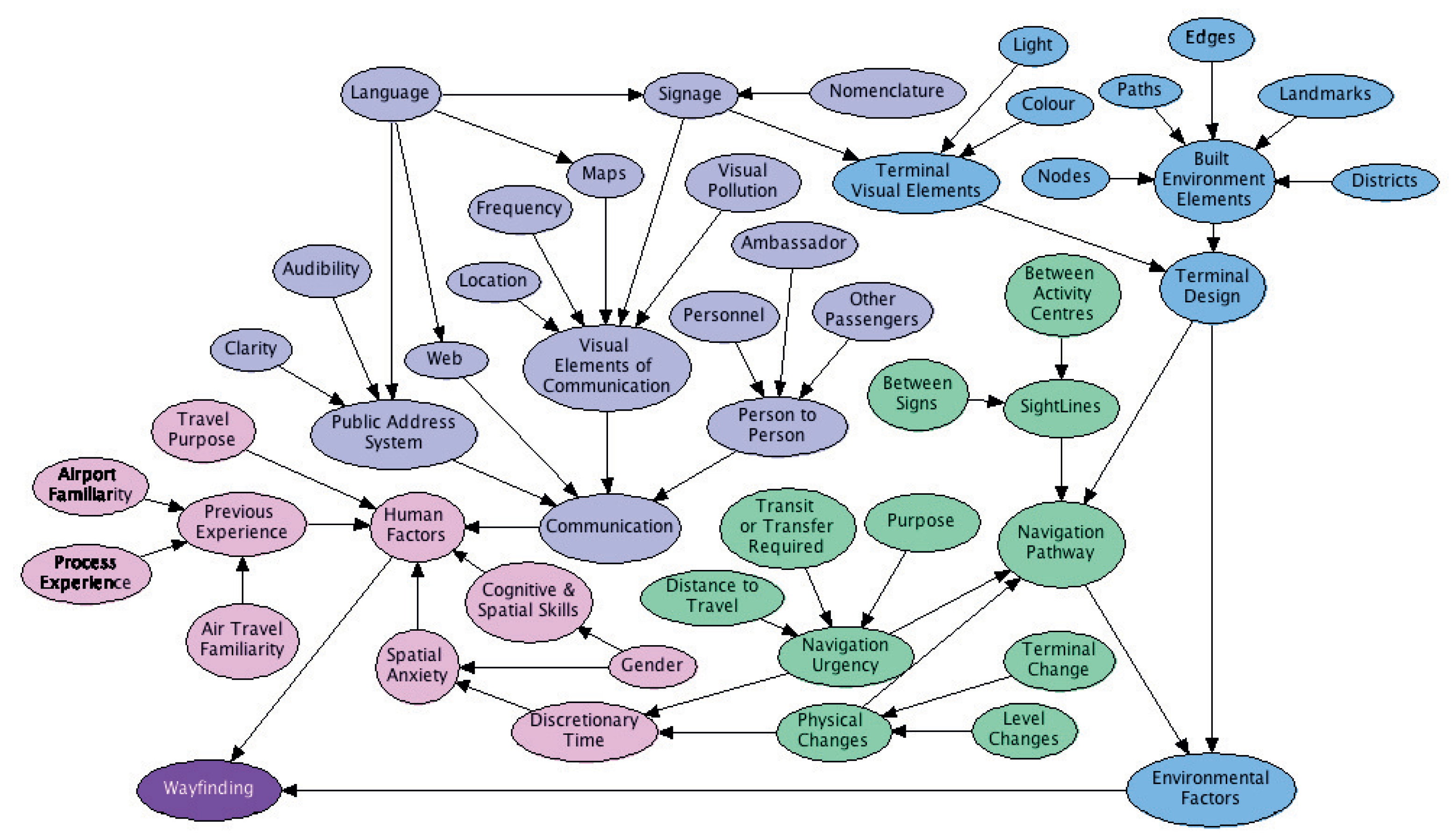
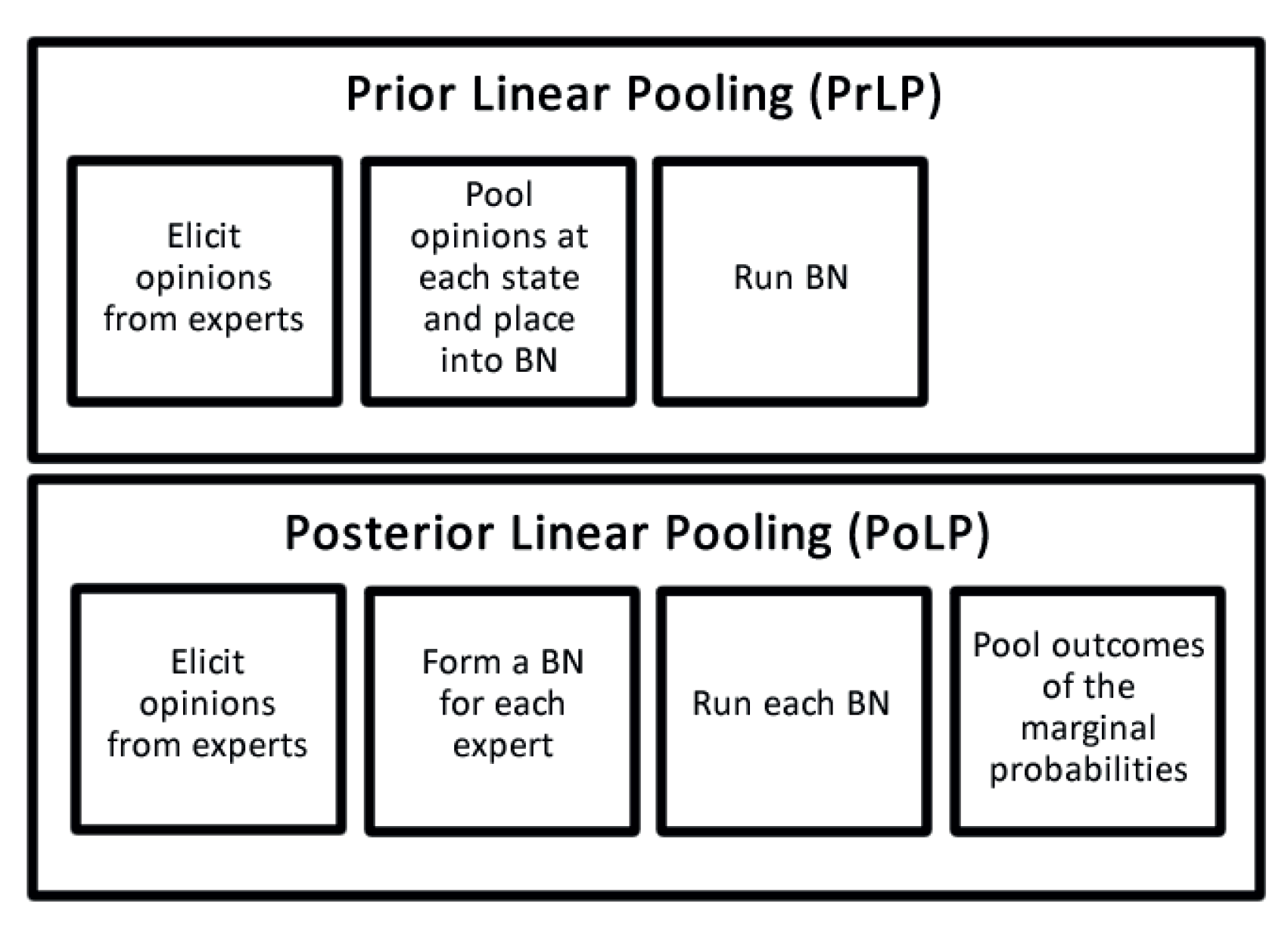

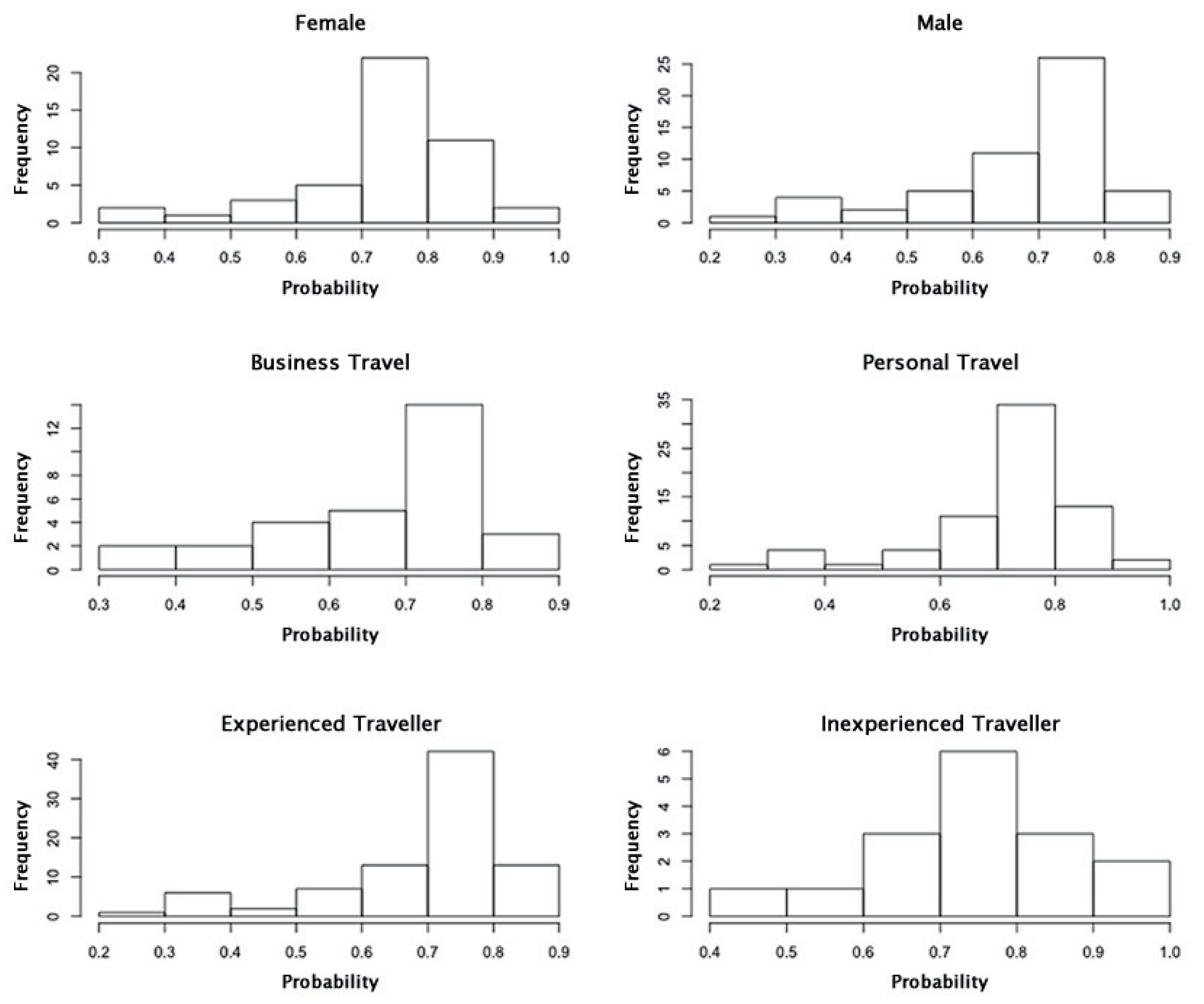
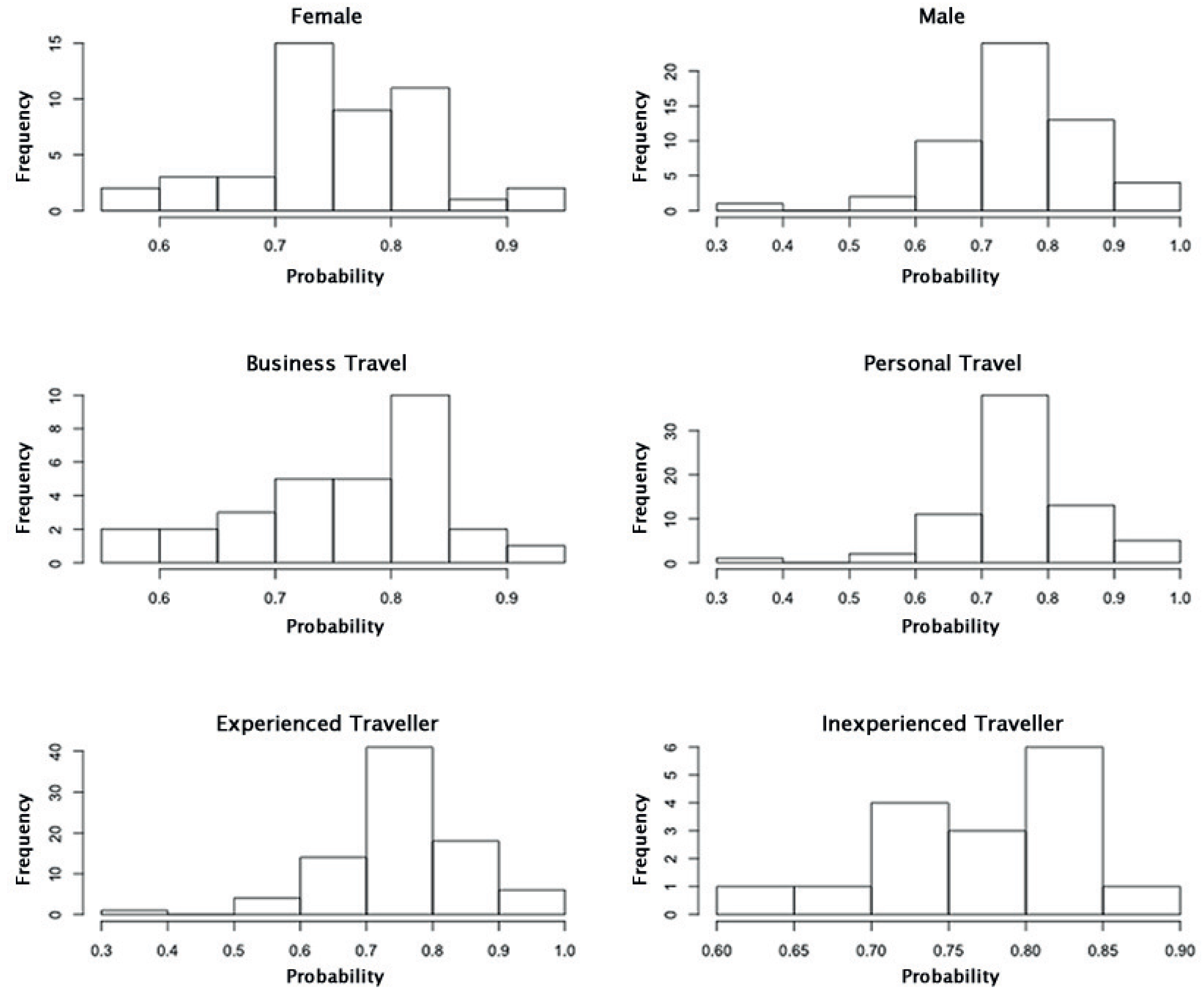
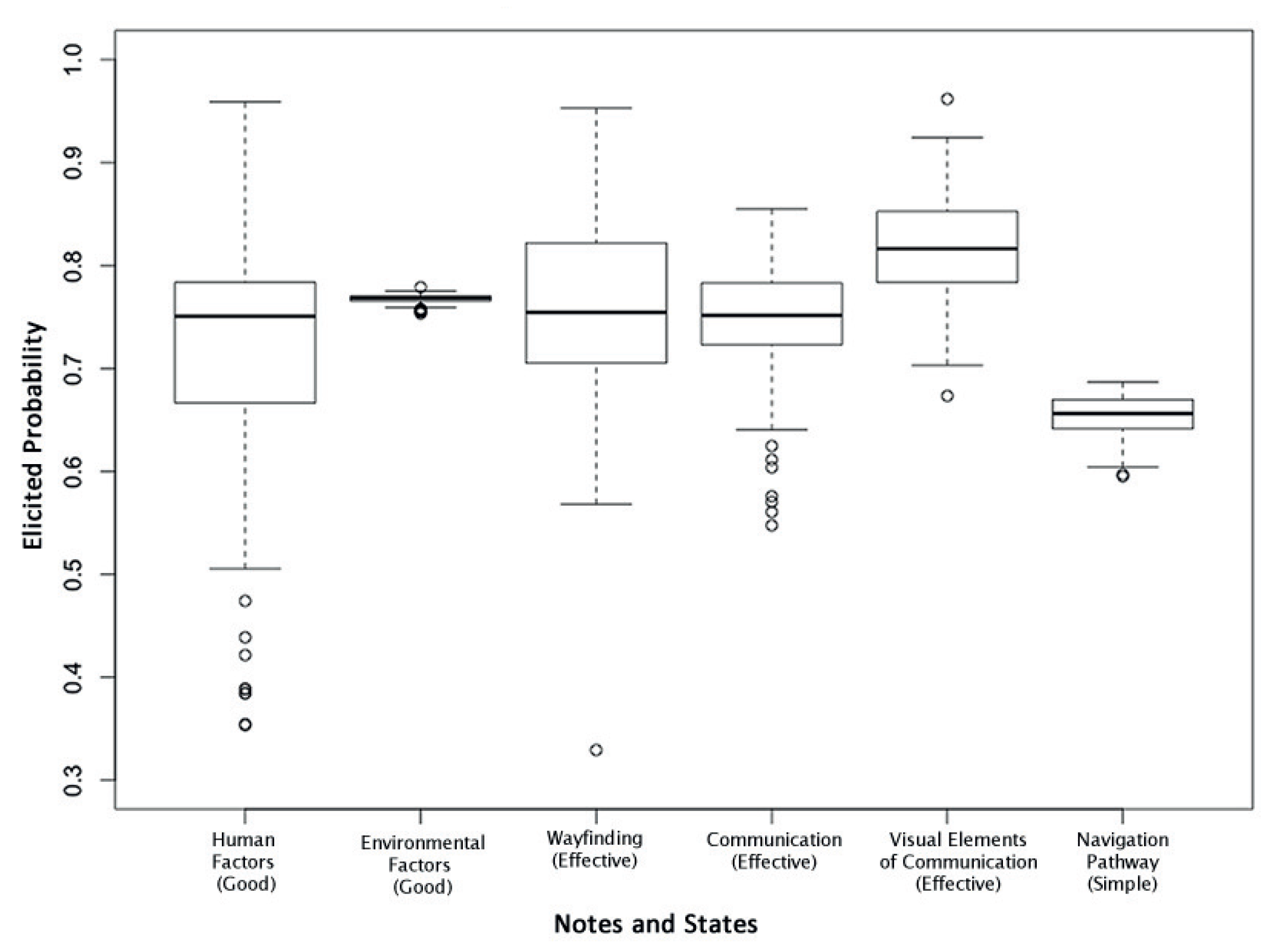
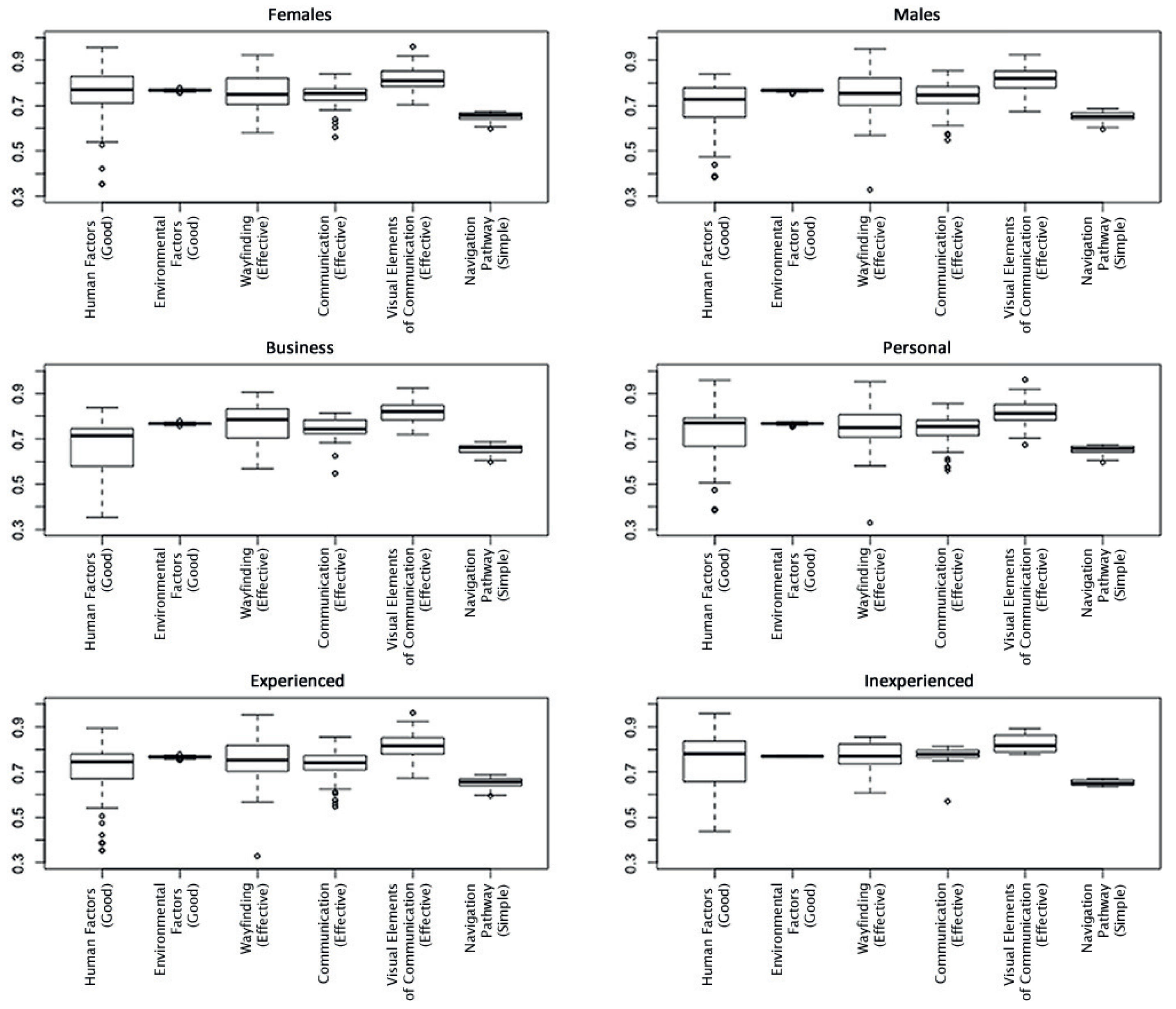
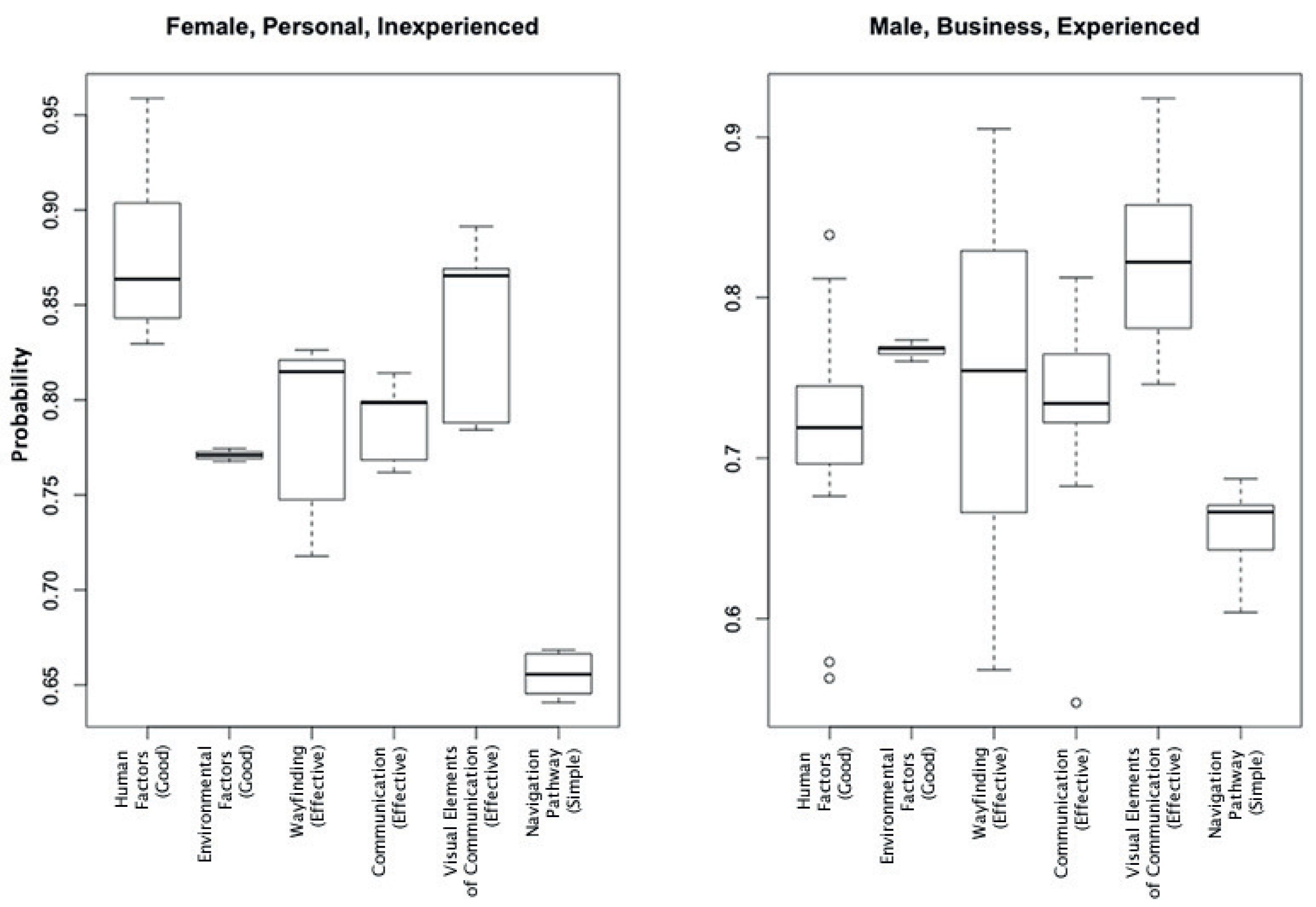
| Method | Advantages | Disadvantages |
|---|---|---|
| Prior Linear Pooling (PrLP) | · Smaller number of steps are required to obtain marginal probabilities of interest. · Having only one BN makes updating information easier and more timely. · Diagnostic, predictive, and intercausal reasoning are easier to undertake. | · Pooling, when used with BNs do not follow a coherent probability model [25]. · Since each of the probabilities given by the experts are pooled within each entry of the CPT, the resulting averages are not a reflection of what was originally given by the expert for that entry, and so the conditional independence structure is lost. |
| Posterior Linear Pooling (PoLP) | · The conditional independence structure of the BN is maintained. | · More steps are required in order to obtain the marginal probabilities of interest. · Updating information can be time consuming if there are a large number of experts, and hence BNs. · Diagnostic, predictive, and intercausal reasoning is also time consuming if there are a large number of experts. This is because each individual BN must be modified and then pooling once again done to obtain the marginal probabilities of interest. |
| Node | Description | States |
|---|---|---|
| Communication | The effectiveness of communication in the airport terminal | Effective, Ineffective |
| Environmental Factors | The level of the environmental factors such as terminal design and navigation pathway complexity that contribute to effective wayfinding in airport terminals | Good, Bad |
| Human Factors | The level of the human factors such as spatial anxiety and cognitive and spatial skills that contribute to effective wayfinding in airport terminals | Good, Bad |
| Navigation Pathway | The complexity of the navigation pathway that a passenger must traverse in order to reach a desired destination in the airport terminal | Simple, Complex |
| Visual Elements of Communication | The quality of the visual elements of communication in the airport terminal | Good, Bad |
| Wayfinding | The effectiveness of wayfinding in the airport terminal | Effective, Ineffective |
| Group | Human Factors Good | Wayfinding Effective |
|---|---|---|
| All | 0.8033 | 0.8057 |
| Female | 0.7790 | 0.7876 |
| Male | 0.8369 | 0.8305 |
| Business | 0.8033 | 0.8057 |
| Personal | 0.8033 | 0.8057 |
| Experienced | 0.8135 | 0.8132 |
| Inexperienced | 0.7458 | 0.7683 |
| Good Human Factors | Effective Wayfinding | |
|---|---|---|
| All | 0.8033 | 0.8057 |
| Female, Experienced | 0.7880 [0.0153] | 0.7943 [0.0114] |
| Female, Inexperienced | 0.7282 [0.0751] | 0.7500 [0.0557] |
| Male, Experienced | 0.8487 [0.0454] | 0.8393 [0.0336] |
| Male, Inexperienced | 0.7701 [0.0332] | 0.7810 [0.0247] |
| Group | Communication Effective | Environmental Factors Good | Human Factors Good | Navigation Pathway Simple | Visual Elements of Communication Good |
|---|---|---|---|---|---|
| Full network | 0.8115 | 0.7697 | 0.8033 | 0.6893 | 0.7087 |
| Female | 0.8183 [0.0068] | 0.7931 [0.0234] | 0.9410 [0.1377] | 0.6941 [0.0048] | 0.7114 [0.0027] |
| Male | 0.8239 [0.0012] | 0.7901 [0.0020] | 0.9587 [0.1554] | 0.6935 [0.0042] | 0.7137 [0.0050] |
| Business | 0.8207 [0.0092] | 0.7918 [0.0021] | 0.9487 [0.1454] | 0.6939 [0.0046] | 0.7124 [0.0037] |
| Personal | 0.8207 [0.0092] | 0.7918 [0.0021] | 0.9487 [0.1454] | 0.6939 [0.0046] | 0.7124 [0.0037] |
| Experienced | 0.8201 [0.0086] | 0.7947 [0.0022] | 0.9518 [0.1485] | 0.6937 [0.0044] | 0.7121 [0.0034] |
| Inexperienced | 0.8246 [0.0013] | 0.7947 [0.0025] | 0.9300 [0.1267] | 0.6945 [0.0052] | 0.7139 [0.0052] |
| Group | Communication Effective | Environmental Factors Good | Human Factors Good | Navigation Pathway Simple | Visual Elements of Communication Good | Wayfinding Effective |
|---|---|---|---|---|---|---|
| All | 0.7415 | 0.7672 | 0.7082 | 0.6509 | 0.8188 | 0.7517 |
| Female | 0.7430 [0.0014] | 0.7680 [0.0007] | 0.7400 [0.0318] | 0.6524 [0.0015] | 0.8194 [0.0006] | 0.7546 [0.0029] |
| Male | 0.7403 [0.0012] | 0.7666 [0.0006] | 0.6811 [0.0270] | 0.6495 [0.0013] | 0.8182 [0.0005] | 0.7492 [0.0024] |
| Business | 0.7413 [0.0002] | 0.7674 [0.0001] | 0.6698 [0.0383] | 0.6517 [0.0008] | 0.8206 [0.0018] | 0.7585 [0.0067] |
| Personal | 0.7416 [0.0001] | 0.7672 [0.00006] | 0.7247 [0.0164] | 0.6505 [0.0003] | 0.8180 [0.0007] | 0.7488 [0.0029] |
| Experienced | 0.7363 [0.0052] | 0.7666 [0.0006] | 0.7006 [0.0076] | 0.6503 [0.0005] | 0.8180 [0.0007] | 0.7485 [0.0031] |
| Inexperienced | 0.7690 [0.0274] | 0.7705 [0.0032] | 0.7482 [0.0399] | 0.6537 [0.0028] | 0.8230 [0.0041] | 0.7683 [0.0165] |
© 2018 by the authors. Licensee MDPI, Basel, Switzerland. This article is an open access article distributed under the terms and conditions of the Creative Commons Attribution (CC BY) license (http://creativecommons.org/licenses/by/4.0/).
Share and Cite
Farr, C.; Ruggeri, F.; Mengersen, K. Prior and Posterior Linear Pooling for Combining Expert Opinions: Uses and Impact on Bayesian Networks—The Case of the Wayfinding Model. Entropy 2018, 20, 209. https://doi.org/10.3390/e20030209
Farr C, Ruggeri F, Mengersen K. Prior and Posterior Linear Pooling for Combining Expert Opinions: Uses and Impact on Bayesian Networks—The Case of the Wayfinding Model. Entropy. 2018; 20(3):209. https://doi.org/10.3390/e20030209
Chicago/Turabian StyleFarr, Charisse, Fabrizio Ruggeri, and Kerrie Mengersen. 2018. "Prior and Posterior Linear Pooling for Combining Expert Opinions: Uses and Impact on Bayesian Networks—The Case of the Wayfinding Model" Entropy 20, no. 3: 209. https://doi.org/10.3390/e20030209





